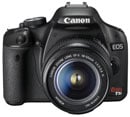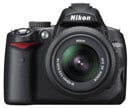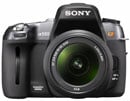Canon EOS 550D / Rebel T2i
-
-
Written by Gordon Laing
Canon EOS 550D / Rebel T2i verdict
Canon’s EOS 550D / Rebel T2i is a very impressive DSLR which redefines what we can expect from the upper entry-level category. Just five months on from the high-end EOS 7D, the EOS 550D / T2i delivers essentially the same image quality and flexible movie modes at half the price. Sure the EOS 550D / T2i doesn’t share the build quality, speed and handling of the EOS 7D, but with 18 Megapixels and HD video at a choice of frame rates and sizes, it’s a powerful camera for the price.
Let’s start with those headline features. In our tests, the EOS 550D / T2i delivered images which were essentially the same as those from the EOS 7D: they’re highly detailed and manage to keep noise levels under roughly the same control as Nikon does with its 12 Megapixel models. Considering a 50% hike in total pixel count, that’s a decent achievement. You can see a full report with both JPEG and RAW files in our results pages.
Moving onto video, the earlier EOS 7D impressed with its ability to offer HD video in 1080p at 24, 25 and 30fps, along with 720p at 50 or 60fps. Now the EOS 550D / T2i offers exactly the same facilities, and also inherits an external microphone input, full manual control over exposures and the ability to trim clips in-camera. Canon came under fire for delivering a slightly hobbled video experience with the earlier 500D / T1i, and it’s not going to make the same mistake twice. Indeed, the EOS 550D / T2i offers an additional Movie Crop mode you won’t even find on the EOS 7D (at least at the time of writing), which only records the central 640×480 pixels of the sensor to deliver a highly magnified view. The output may only be standard definition, but the ability to effectively magnify any of your lenses by 7.2x presents the opportunity to get much closer to distant subjects. You can see examples of the Movie Crop and Manual exposure modes in our Movie mode page, where we’ve also gone over all the other features and the full filming experience.
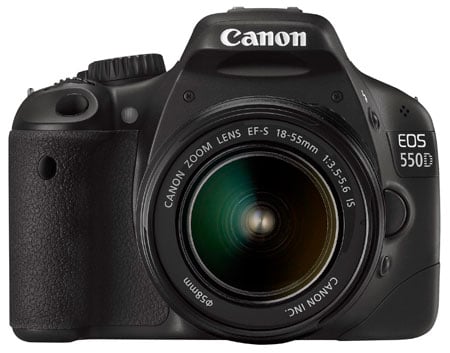 |
You’d be forgiven for thinking the EOS 550D / T2i is only about its high resolution sensor and multiple video modes, but there are two other important additions.
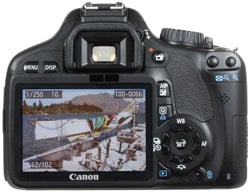 | |
Physically it becomes the first Canon DSLR to sport a 3:2 aspect ratio screen which perfectly matches the native shape of its sensor, so images in Live View and playback fill the screen without black bars above or below. HD video in 16:9 is also a better fit for the new screen with thinner black bars above and below. It’s also slightly more detailed than earlier 3in VGA screens, which coupled with the images actually filling the screen, means you’ll be seeing them look sharper than before. It’s a great upgrade we look forward to seeing on other DSLRs in the future.
Inside the camera, the AF system and viewfinder experience may be unchanged, but in an unexpected move, Canon’s adopted the 63-zone iCFL metering system introduced with the EOS 7D. It really makes a difference too, as we the 550D / T2i’s metering more consistently reliable than earlier models.
Beyond these four major enhancements, the EOS 550D / T2i also supports SDXC and Eye-Fi memory cards, along with CEC on the HDMI port for control with a compatible TV remote.
So far so good, but what you won’t find on this new model is significantly improved build or handling, nor anything too left-field like an articulated screen or built-in GPS. Canon’s strategy for its entry-level and mid-range models remains the same as before: boost the resolution, improve the video, filter-down a handful of features from an existing higher-end model, but leave quick continuous shooting, tough build, PC Sync ports and a big viewfinder for the semi-pro range. And despite Canon selling bucket-loads of PowerShot SXx0 super-zooms, it continues to resist fitting an articulated screen on any of its DSLRs – a shame considering it leads the pack in video functionality.
This strict categorisation may be understandable within Canon’s own range, but it has opened up opportunities for rival manufacturers. Nikon, Olympus and Sony all offer DSLRs with articulated screens, Pentax has gone down the tougher build route, while Sony additionally offers affordable models with quick continuous shooting. If any of these features are critical to you, then you’ll be better off looking beyond the Canon range at this price point.
If you’re the kind of photographer who curses each new entry-level Canon DSLR for prioritising resolution and video over quicker shooting or tougher build though, don’t forget to keep an eye on the gradually falling prices of its semi-pro range. For example, for little more than the basic EOS 550D / T2i kit, you could alternatively buy the EOS 50D body, which may not offer video, but does boast much tougher build, much faster continuous shooting, a far superior viewfinder and a PC Sync port for connecting to external lighting. The 3 Megapixel difference is barely noticeable in real-life shots, and if you’re an action shooter, you’ll appreciate the benefits of this model.
It’s also worth noting while the improved screen and metering are nice upgrades, the major benefit of the EOS 550D / T2i over its predecessor is the 18 megapixel resolution and choice of HD video modes. So if you’re happy with 15 Megapixels and 720p at 30fps, then the EOS 500D / T1i could be a bargain buy. Which brings us to our comparison against rival models.
Compared to Canon EOS 500D / Rebel T1i
Canon’s older EOS 500D / Rebel T1i is expected to sell alongside the new EOS 550D / T2i as a more affordable option between it and the entry-level EOS 1000D / XS – as such, the 500D / T1i effectively replaces the ageing 450D / XSi. Externally, both the EOS 500D / T1i and the new 550D / T2i look virtually identical, with the same size, weight, and similar styling, not to mention the same viewfinder, AF system and ISO range, but within there’s a number of key differences. Most obviously the EOS 550D / T2i sports 18 Megapixels to 15.1 on the 500D / T1i; at 300 dpi, these images can be reproduced at up to 17.3×11.5in, compared to 15.8×10.5in on the older model. Both models can record HD video, but the 550D / T2i offers a wider choice of frame rates: the older 500D / T1i offered HD at either 720p in 30fps or 1080p in 20fps, whereas the new 550D / T2i offers 720p at 50 or 60fps or 1080p at 24, 25 or 30fps. The older model would only shoot video in fully automatic with audio recorded by a built-in microphone, whereas the new model additionally offers manual exposure controls and an external microphone input. Both cameras feature 3in high resolution screens, but the 550D / T2i’s sports a wider 3:2 aspect ratio which matches the shape of the images, allowing them to fill the screen in Live View or playback; HD movies also fill more of the screen than before. Beyond the sensor resolution, screen and movie options, the 550D / T2i features a much more sophisticated metering system, support for SDXC and Eye-Fi memory cards along with CEC on the HDMI port for control with a compatible TV remote, and slightly quicker continuous shooting (3.7fps vs 3.5fps).
Overall, this represents a decent upgrade over the 500D / T1i, especially at a launch price that was only around 15% higher at the time of writing. But as news of the new model spreads, prices on the older one are bound to fall, and unless you really want the variable frame rates, smooth 1080p video, manual movie exposures and external microphone input, the older 500D / T1i remains a great camera. Keep an eye on prices as you may find a bargain. See our Canon EOS 500D / T1i review for more details. |
Compared to Canon EOS 50D
The EOS 50D is the next model up in Canon’s DSLR range, and while it’s been over-shadowed by the EOS 7D, it remains a compelling option at a price that steadily falls. After all, for much the same price as the EOS 550D / T2i basic lens kit, you could get yourself an EOS 50D body and enjoy semi-pro performance. In its favour, the EOS 50D is a much tougher and quicker camera. It boasts a magnesium alloy shell which will better handle the knocks, and considerably quicker 6.3fps continuous shooting. The AF system may also have 9-points, but all are more sensitive cross-type sensors (with lens micro-adjustment) and you’ll be framing with a bigger and brighter penta-prism optical viewfinder. There’s also an upper LCD information screen, a PC-sync port for connection to external lighting systems, a more powerful battery and an optional Wifi transmitter. It is in short, a much more professional DSLR. As an older model though, the EOS 50D is lacking some bells and whistles of the latest models, most notably with no movie mode of any description. The EOS 550D / T2i also features a more sophisticated metering system and that wider screen, although the 3in VGA screen of the 50D still looks great. The 550D / T2i also boasts three extra Megapixels, but the 15.1 of the 50D will be sufficient for many. The bottom line is the 50D offers a lot more for traditional photographers than the EOS 550D / T2i, and if you’re not bothered about video, it’s arguably a better bet. This especially applies to anyone wanting to shoot action or work in more challenging environments. See our Canon EOS 50D review for more details. |
Compared to Nikon D5000
At the time of writing, Nikon’s upper entry-level DSLR was the D5000. As an older model it’s again lacking some bells and whistles, but in the absence of a new model (for now), this is the main rival for the EOS 550D / T2i. At first glance, the Canon EOS 550D / T2i trumps the D5000 in a number of key specifications: the resolution is much greater (18 Megapixels versus 12.3), the maximum sensitivity is higher (12800 ISO compared to 6400), tonal depth is greater (14 bits versus 12), the screen is bigger and more detailed (3in / 1040k vs 2.7in / 230k), not to mention being a better shape for images and movies, the viewfinder slightly larger and the headline movie mode can now capture 1080p or 720p video at a variety of frame rates compared to 720p at a fixed 24fps. The 550D / T2i also has an external microphone input, support for larger SDXC cards, and like all Canon DSLRs, you also get free PC / Mac based remote control and decent RAW conversion software. It’s not all one-sided though. In its favour the D5000 has a fully-articulated screen which allows great compositional flexibility in Live View, it sports quicker continuous shooting (4fps vs 3.7fps), a slightly more sophisticated AF system (11-point versus 9-point), on-demand grid lines in the optical viewfinder, and an easy user interface for beginners. Many will also prefer the Motion JPEG compression system employed by Nikon which is much easier to edit than the H.264 format used by Canon. Despite these benefits, the latest Canon has now taken a significant lead in resolution and movie mode options, but it’s important to compare pricing. At the time of writing, the year-old D5000 kit had fallen to a price around 30% lower than the launch price of the EOS 550D / T2i. That’s a big difference and it’s also important to remember the D5000 features excellent image quality and a 720p movie mode that’s good enough for many. Considering you’re also getting a flip-out screen in a package costing around two thirds of the new Canon, the D5000 looks like a bargain. See our Nikon D5000 review for more details. |
Compared to Sony Alpha DSLR-A500 and A550Sony’s Alpha DSLR A500 and A550 are interesting options priced just below and above the EOS 550D / Rebel T2i. They’re interesting because while neither Sony offers any kind of video recording, they do offer faster operation which will undoubtedly appeal more to action photographers on a budget. In their favour, the Alpha A500 and A550 feature built-in stabilisation which works with any lens you attach, articulated screens which vertically tilt to face directly up or down, much faster continuous shooting at 5fps (boostable to 7fps on the A550 if you’re willing to lock the focus), a choice of two Live View modes, one of which is much faster than the Canon while additionally supporting continuous AF, and a face detection system which is actually usable thanks to the phase-change AF behind it. The battery also delivers an accurate percentage of charge remaining, there’s in-camera HDR capture, and first-time DSLR owners may find the user interface more approachable. While the Canon 550D / T2i’s resolution is comfortably higher, the most important difference in its favour is a movie mode which can shoot 720p or 1080p video at a variety of frame rates with the choice of manual exposure control and an external microphone input. It also has a depth-of-field preview, comes with free software to remote control the camera from a PC or Mac, is almost 150g lighter for the body and battery alone, and supports SDXC cards. If we’re being picky, the Canon also displays the ISO value at all times in the viewfinder, whereas the Sony does not, and it additionally features more consistent on-screen adjustment of settings. The only aspect where the Sonys really fall down in the comparison though are their lack of video recording, and of course this may not bother you at all. Indeed if you prioritise speed of operation and built-in stabilisation over video recording, you’ll prefer the Sony A500 and A550. But if you’re going for the pricier of the pair, do also take a close look at the Canon EOS 50D. See our Sony Alpha DSLR-A550 review for more details. |
Canon EOS 550D / Rebel T2i final verdict
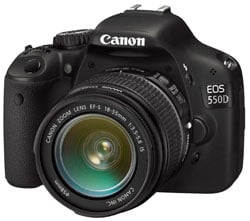 |
Canon’s EOS 550D / Rebel T2i continues the company’s tradition of filtering-down features from a higher-end model into a more affordable body. As such, the 550D / T2i enjoys the same high resolution photos and flexible movie modes of the 7D, not to mention its sophisticated metering system, and there’s even a brand new 3:2 shaped screen which is a perfect fit for stills in playback or Live View.
These features, along with the other improvements listed above, are of course all very nice to have, but there’s nothing too radical here. Canon continues to have no interest in fitting articulated screens to its DSLRs for now, nor will you find anything left-field like a built-in GPS. And while the resolution and movie specifications read like a mini 7D, the company ensures the entry-level models are kept well apart from the semi-pro DSLRs by keeping construction affordable and continuous shooting below 4fps.
Given Canon’s track record, none of this should come as any surprise. Its entry-level and mid-range models will always prioritise resolution (and now also video capabilities) over continuous shooting, although this firm strategy has opened gaps for companies like Sony to pitch affordable DSLRs with quick burst rates which many will find preferable.
It’s also important to remember if you’re not interested in video, Canon’s own EOS 50D is currently priced only slightly higher with the benefits of quicker shooting, tougher build and other pro features. Then coming-in at a comfortably lower price point is Nikon’s D5000, which may be a year old but still features great image quality and respectable 720p movies, along with an articulated screen. Both will be tough rivals for the latest Canon. We’d also be surprised if Nikon doesn’t announce a compelling successor to the best-selling D90 by the Photokina show this September.
Ultimately much of the EOS 550D / T2i’s appeal lies in its flexible movie capabilities, and it’s great to have not only the 7D’s choice of frame rates, but also manual control over exposures and an external microphone input. If these features are important to you, then the 550D / T2i lets you enjoy them at a lower price than ever before. Indeed it’s a fantastic camera for videophiles on a budget, while the 18 Megapixel resolution, confident metering and superb screen will delight still photographers. As such it easily earns our Highly Recommended rating and in the absence of an updated equivalent from arch rival Nikon, it’ll own much of the upper entry-level DSLR sales during 2010.
